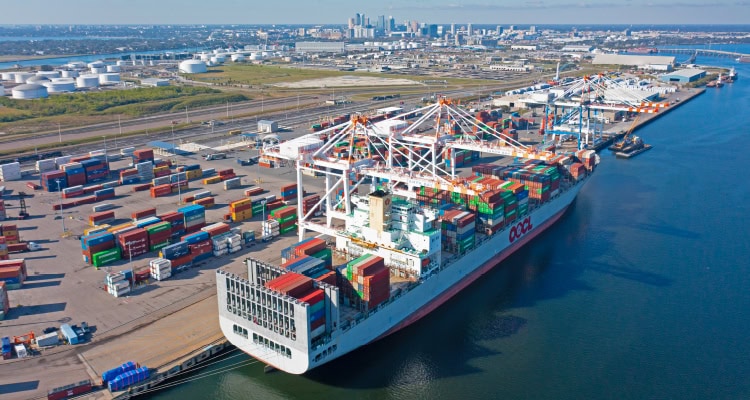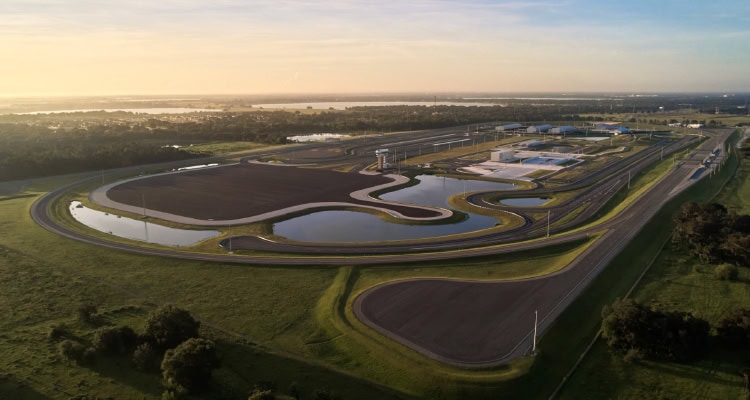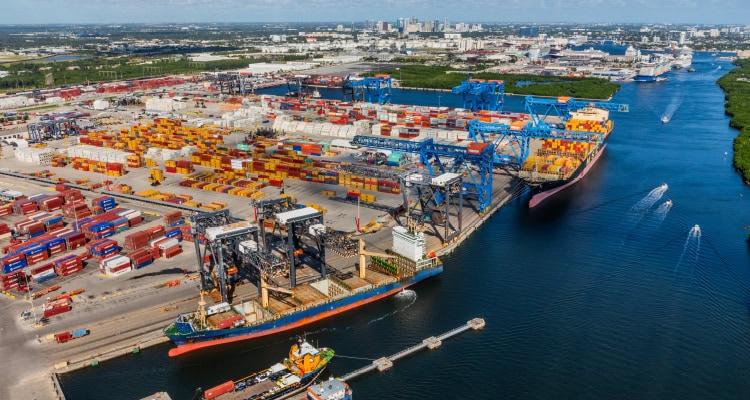Future-Proofing Florida

Florida’s strong transportation infrastructure has long made it a key U.S. logistics hub. Now, the state is looking ahead, investing to meet growing supply chain demands.
With more than 12,000 miles in Florida’s state highway system and approximately 1,350 miles of coastline, it has been said that the Sunshine State is a driver’s paradise. But to think of those numbers only in the context of people traveling—some 22 million residents and 143 million visitors each year—is to tell only part of Florida’s story. The state’s transportation infrastructure also moves cargo at a volume and speed that qualifies Florida as a logistics powerhouse.
The flow of cargo and goods will not slow down anytime soon. Call it “future-proofing”: The state and its logistics assets are on course with plans and improvements to ensure that Florida will continue to meet and exceed the needs of shippers and logistics providers for generations to come.
In his fiscal year 2025-26 budget, for example, Florida Gov. Ron DeSantis announced steps to support the state’s transportation network and infrastructure, including:
$13.8 billion for the state transportation work program to construct and maintain Florida’s transportation network.
The immediate advancement of $1.7 billion to expedite congestion relief along Interstate 4.
$25 million for Florida’s ports, logistics centers, fuel pipelines, and vertiports, which are specialized hubs designed for the take-off, landing, and servicing of vertical take-off and landing (VTOL) aircraft, such as drones and air taxis.
The state is a crucial logistics hub for the United States and the Western Hemisphere, serving as a critical gateway for trade between North America, Latin America, and the Caribbean. Its importance stems from a combination of geographic advantages, robust infrastructure, and major ongoing investments.
Port Power

Recent and ongoing capital improvements at Port Tampa Bay include a project to deepen the channel from 43 feet to 47 feet, expand the container terminal to 100 acres, add new truck gates, extend container berths, and add more post-Panamax cranes.
One significant player in the story of Florida’s leadership in logistics is Port Tampa Bay, the state’s largest and most diverse port. The port’s importance is set to increase with a project Congress authorized in 2024 to deepen the federal channel from 43 feet to 47 feet. Called the Tampa Harbor Navigation Improvement Project, the massive undertaking received federal funding for design and permitting this year.
The estimated cost is approximately $1.1 billion. Financing for the deepening project comes from a federal, state, and local cost-share through the U.S. Army Corps of Engineers, the Florida Department of Transportation, and Port Tampa Bay. Other terminal expansions and equipment upgrades are funded through a mix of port revenues, state infrastructure grants, and private-partner investments.
The U.S. Army Corps of Engineers and Port Tampa Bay expect deepening to begin in 2028, with completion targeted for 2033.
Deepening to 47 feet will allow the port to accommodate deeper draft vessels, creating new opportunities for direct all-water services from Asia and other global trade lanes, says Raul Alfonso, executive vice president and chief commercial officer, Port Tampa Bay. Shippers will benefit from greater vessel efficiency, reduced transshipment costs, and improved schedule reliability.
“The project will strengthen the port’s position as a major logistics gateway for Florida’s rapidly growing consumer base,” Alfonso explains. “It’s projected to support thousands of construction and maritime jobs, generate hundreds of millions in wages, and unlock billions in trade growth. The expanded capacity will also enhance Florida’s supply chain resilience by keeping more freight flowing through in-state ports.”
Port Tampa Bay also continues to invest alongside the deepening project. Recent and ongoing capital improvements include expansion of the container terminal to 100 acres, new truck gates with advanced operating systems, and additional post-Panamax cranes, bringing the total to seven cranes.
In addition, the port extended container berths from 3,200 to 4,500 linear feet and added a rail-served transload facility to improve intermodal efficiency.
For shippers, the combination of deeper water and expanded infrastructure means faster turn times, more reliable vessel schedules, and lower overall logistics costs. The port’s location near Florida’s largest concentration of distribution centers offers efficient truck access across the state and competitive northbound backhaul rates.
Meanwhile, Florida is investing heavily in highway, rail, and logistics corridors, including the I-4 and I-75 connectors that link Tampa Bay to Orlando and beyond. The port’s deepening and terminal expansion projects complement these statewide efforts by ensuring maritime capacity keeps pace with inland distribution growth.
“These investments reflect Port Tampa Bay’s long-term strategy of building ahead of demand,” Alfonso says. “We’re committed to ensuring that our customers—and Florida’s economy—have the infrastructure, capacity, and reliability needed to compete in a changing global marketplace.”
With Florida’s population growth projected to reach 25 million by 2030, the combined projects enhance Port Tampa Bay’s strategic location, just minutes away from the majority of the region’s distribution hubs.
“We are also able to grow the land size of our port, giving us a strategic advantage of being able to sustain long-term growth,” Alfonso says. “That will cement our role as Florida’s most diversified and strategically located port, serving the state’s booming consumer and industrial economy.”
Statewide Strength

The first of two Advanced Air Mobility vertiports is under construction at FDOT’s SunTrax in Auburndale. These specialized hubs will support transportation via innovative aircraft such as drones and air taxis.
Nearly every major global logistics integrator has a presence in Florida. Home to more than 11,500 logistics and distribution establishments, Florida is the ideal choice for logistics, supply chain, and distribution companies to locate and for freight to make the journey to its final destination.
The broader wholesale trade, transportation, and logistics sector in Florida accounts for more than 63,000 individual entities and employs more than half a million individuals across the state. As the Western Hemisphere’s commercial gateway, Florida is a top choice for any company in search of global access and a direct path to rapidly expanding markets in Latin America and the Caribbean.
As part of its plans to “future-proof” these strengths, the state announced major steps for congestion relief in Central Florida, including 17 miles of new express lanes on I-4 in Hillsborough County and a new truck parking facility along the I-4 corridor in Polk County.
These express lanes will bring significant congestion relief to the traveling public by separating long-distance traffic from local commuter traffic, providing additional reliable travel options and enhancing the quality of life for residents traveling in the area. This project has officially been programmed within the Florida Department of Transportation (FDOT) project pipeline and will be advanced by 10 years, with construction expected to begin in 2028.
The state is also breaking ground on the nation’s first infrastructure for Advanced Air Mobility (AAM), an emerging aviation concept that uses new types of aircraft—often electric or hybrid-electric and capable of eVTOL—to move people and cargo efficiently across urban, regional, and rural environments.
“Through our Moving Florida Forward initiative, we are making record infrastructure investments and completing projects ahead of schedule to meet the needs of our growing state,” says Gov. DeSantis.
To further support Florida’s freight traffic along the I-4 corridor, which has one of the largest truck parking deficits throughout the state, FDOT will also be constructing a new 100-space truck parking facility in Polk County at the Polk Parkway and I-4 interchange. This advancement reflects the state’s commitment to fiscal prudence by maximizing available resources, as the new truck parking facility will utilize existing right-of-way within the interchange.
With 75% of Florida’s total freight moved by trucks, Gov. DeSantis has remained committed to expanding critical truck parking facilities throughout the state to support this vital industry.
The construction of the first of two AAM vertiports is officially underway at FDOT’s SunTrax testing facility, which will be expanded to a statewide network of interconnected commercial vertiports. These facilities are intended to serve as a complementary part of the existing transport system, especially within or near urban areas, to facilitate advanced air mobility and shorter travel times. The SunTrax facility will establish the nation’s first-ever AAM aerial test bed and dedicated airspace, driving innovative research and development for this emerging technology. FDOT will release additional announcements related to Florida’s role in AAM in the coming months.
With copious existing resources and ambitious efforts to future-proof its logistics assets, Florida promises to remain out in front of the rapidly growing advances in supply chain and logistics sphere.
Port Everglades in Top 20% Worldwide for Container Port Performance

A global powerhouse for international trade, Port Everglades handles an average of more than one million TEUs annually and serves as a gateway to Latin America, the Caribbean, Europe, and Asia. Located within the Florida cities of Dania Beach, Fort Lauderdale, and Hollywood, Port Everglades is at the heart of one of the world’s largest consumer regions, which includes a constant flow of approximately 156 million visitors statewide and more than 6 million residents within a 100-mile radius.
Port Everglades has direct access to the interstate highway system and the Florida East Coast Railway’s near-dock, 43-acre intermodal container transfer facility, and is closer to the Atlantic shipping lanes than any other Southeastern U.S. port. Ongoing capital improvements and expansion ensure that Port Everglades continues to handle future growth in container traffic.
The port ranks in the top 20% worldwide for container port performance, holding its No. 3 position in North America and No. 1 ranking in Florida, according to the World Bank and S&P Global Market Intelligence’s 2024 Container Port Performance Index (CPPI) released earlier in 2025. Port Everglades is ranked No. 67 worldwide, a shift from its No. 65 spot in the previous CPPI report.
The CPPI rates container ports around the world based on six key events, including how quickly a vessel moves to a berth, how long it takes to move a vessel’s containers, and the time it takes a vessel to exit the port. The 2024 calendar year data covers 403 ports, 175,000 vessel calls, and 247 million cargo moves.
“In nearly every measure, the port’s operational performance is solid and consistent, which speaks to the logistical and infrastructure investments made by both the private and public sector,” says Joseph Morris, CEO and Port Director, Port Everglades. “It’s a credit to our customers and their labor force, the supportive Broward County Board of County Commissioners, and the dedicated staff who work at the port.”
